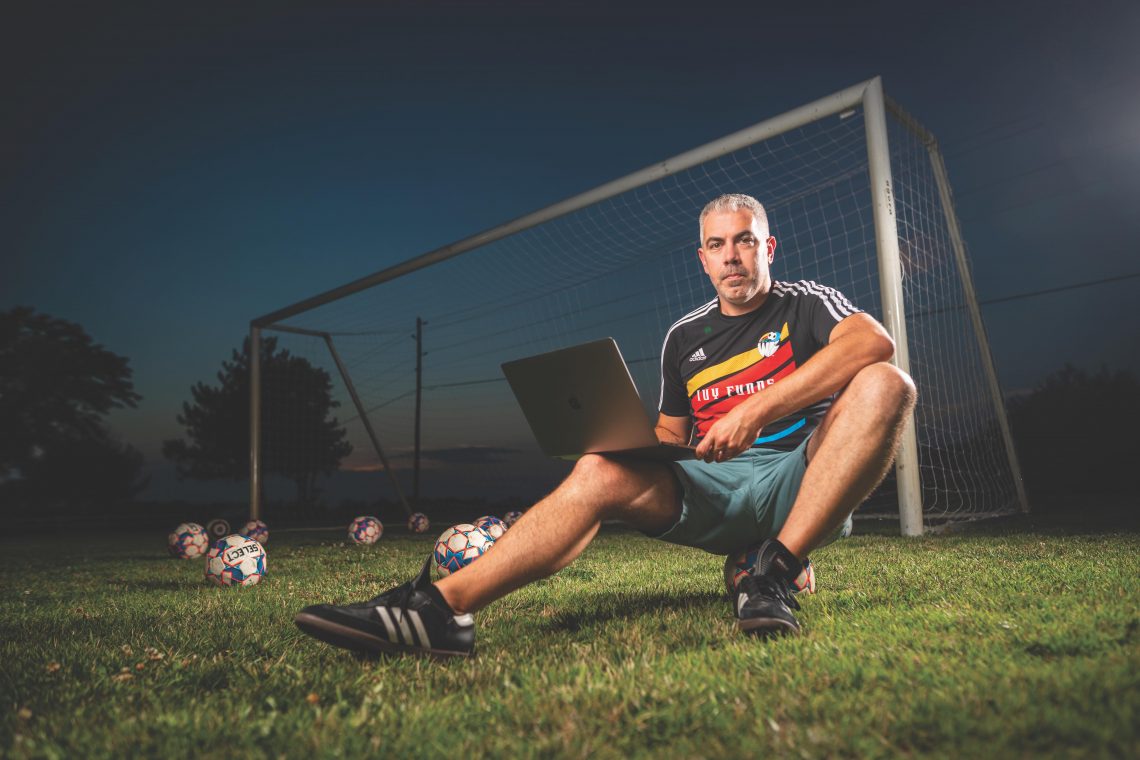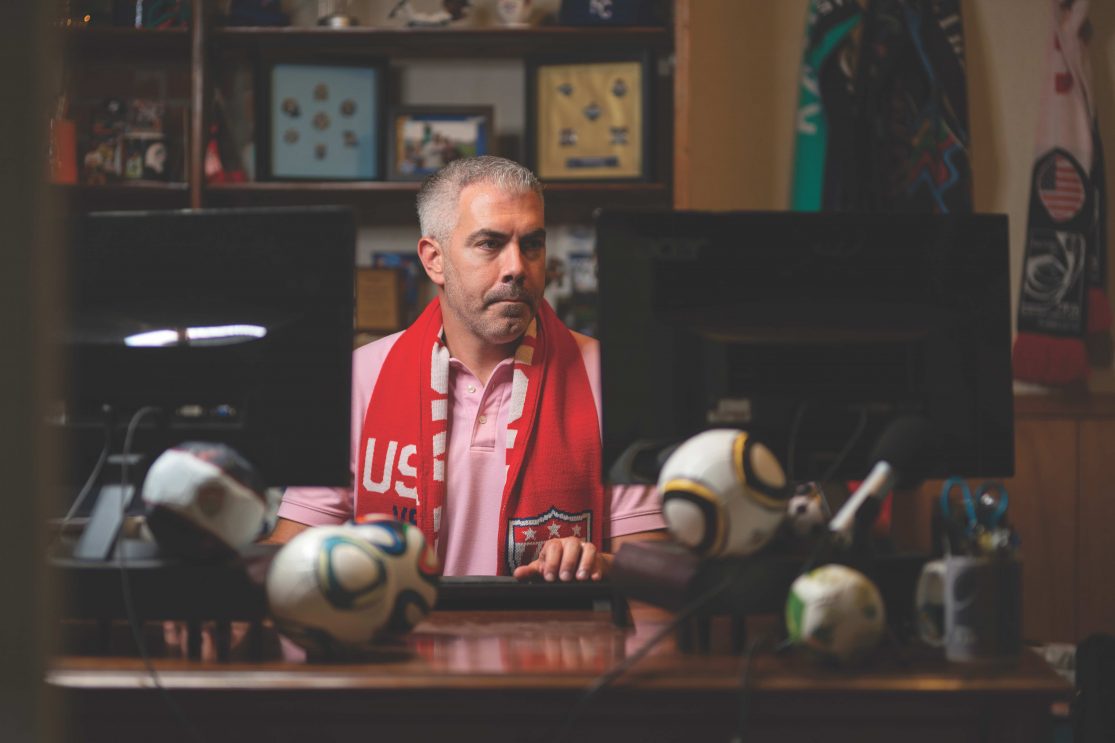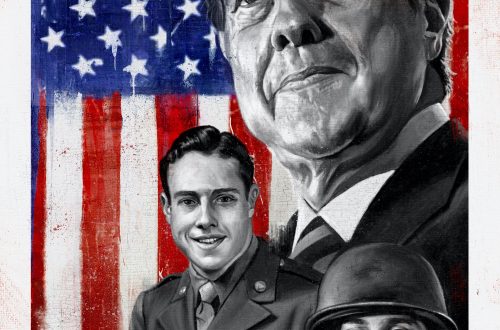
Minds Blown
Topekan Paul Carr has earned an international reputation as one of the quickest, most-authoritative sports-stats gurus
It’s a stormy summer night in Rio de Janeiro. The 2014 World Cup is well underway, and Paul Carr, a longtime Topekan and a senior researcher at ESPN, is on duty behind the scenes for the semifinal broadcast, a clash of two juggernauts: Brazil and Germany. Nearly 6 million people are tuned in to ESPN’s coverage of the game, and as soon as the broadcast is turned over to the commentators, disaster strikes: a power surge from the raging storm causes a blackout in ESPN’s studio, leaving the team in Rio without electricity.
Broadcasters and crew quickly attempt to relocate as water begins seeping through the ceiling of the studio, turning the gray carpet a shade darker. Then, as if things weren’t crazy enough, Germany starts scoring, putting up a record 5 goals in a mere 18-minute span. Chaos ensues, and amid the pandemonium Paul Carr frantically tries to do his job.
“The notes I have to look up keep changing because they keep scoring, like I can’t even get this one looked up because it’s irrelevant already,” says Carr. “And then we have to figure out where we’re doing halftime, because we can’t do it in the studio. … That was probably the nuttiest hour I’ve ever had in my career.”
But Carr came through. By halftime, he had researched and confirmed the following stats that went out live through ESPN broadcasters Alexi Lalas and Mike Tirico: no team had ever scored five goals in the first half hour of a World Cup match (Germany was up 5-0 after 28 minutes), and Brazil had never trailed by four goals in any World Cup match, ever. Carr had conjured all this while working through a blackout and escaping a flooding studio.
This is what Carr does, filling the role of the stats master behind the curtain, digging through loads of sports-analytical data to find the perfect stat, a factoid that “captures the essence, the heart, the truth of the game,” as Roger Bennett, host of the famous soccer podcast Men in Blazers, explains it. “To me,” Bennett adds, “it always seemed like [Carr] was so in tune with data and statistics, that some of his best friends were numbers.”
Carr’s lifelong identification as a sports-stats nerd has led to his working alongside widely known sports pundits such as Scott Van Pelt, Taylor Twellman, and Bob Ley. Carr has spent time covering major soccer tournaments in Germany, South Africa, and Brazil. For years he lived in Connecticut, where ESPN’s headquarters are located. His new job at TruMedia allows him to work remotely, and so in 2018 Carr moved back to Topeka; he now lives with his wife, Heather, and their daughter in a historic house near Gage Park.
Carr’s choice to locate in Topeka wasn’t by chance; he was born in Topeka, where his parents owned RJ Carr’s Family Bookstore, which they operated until 2004. They encouraged his affinity for the intersection of sports and numbers at an early age. “My parents would say I’d be reading the box scores at the table the next morning,” says Carr.
After attending Cair Paravel Latin School, Carr moved on to Wheaton College in Illinois. While Carr had only played soccer casually, preferring theater when he was younger, Wheaton’s successful soccer team and Carr’s interest in sports commentary allowed him to become more familiar with the game. He did play-by-play for matches on the college’s radio station and worked in the sports information department. “That’s really where I learned to love soccer,” says Carr, who also roomed with several members of Wheaton’s team. “I just got to ask questions, because I didn’t know how anything worked.”
After graduating from Wheaton in 2002, Carr came home and “walked into just about every media outlet in Topeka, just to ask, ‘what can I do?’” He landed a job as a producer at 580 WIBW radio, which evolved into more responsibilities, such as doing live commentary for high school football and soccer games for FOX 43, and writing about soccer for the Topeka Capital-Journal. After around five years of this, Carr noticed a job posting for a researcher position at ESPN—a type of role he had not known existed before. “It was tailor-made for me,” he says. He knew experience in broadcasting would certainly help, but being a self-described “sports nerd” turned out to be his key qualification—something the job’s extensive interview process revealed. Besides a timed, written sports-trivia knowledge test, Carr underwent a phone interview in which he was quizzed on “almost literally just trivia.” The first question required Carr to name 10 baseball players with 3,000 career hits. “As soon as they asked the 3,000 hits question, I was like, ‘oh, I’m good here,’” says Carr. “I was the dork who would try to rattle off the 27 or however many people it is, just for fun.” (He’s right—at the time of his interview, there were exactly 27. Now there are 33.)
Despite showing off his vast breadth of sports knowledge in the interview, Carr didn’t land the job immediately, but ESPN called him back several months later. In March 2008, Carr moved to Bristol, Connecticut, to start his job as a researcher at ESPN’s main campus.
His role there consisted of creating notes for anchors to use in upcoming games, building graphics, fact-checking scripts for anchors or producers, and answering any questions broadcasters had. Much of his work was done before the shows went on air, but also, he had an important role to play when they went live. “During the show, you’re in the studio,” Carr says. “By then, ideally, you’re just kind of coasting and making sure nothing blows up, but if there’s breaking news, you gotta make sure the anchors have the right notes and you can build the graphics.” These graphics usually have some statistical or historical angle. Examples include charts displaying World Cup attendance, the locations of a given player’s goals in that World Cup, or a team’s average goals with and without a certain key player.
Carr worked on ESPNEWS, the Mike & Mike in the Morning show, and SportsCenter. Over time, his interest in soccer allowed him to focus on the sport. While at ESPN, he traveled to cover the 2010 Men’s World Cup in South Africa, the 2011 Women’s World Cup in Germany, and the 2014 Men’s World Cup in Brazil. There, Carr met Roger Bennett and Michael Davies, the hosts of the then-nascent Men in Blazers podcast, which is now one of the top soccer podcasts in the world. Bennett and Davies quickly noticed Carr’s aptitude for numbers and figured he deserved a cameo on their show. “The first day, Roger sticks his head in and says, ‘Paul, I want you to come on, give your best stat, and leave,’” recounts Carr. “So after that I come in and give them whatever the stat of the day was, and leave. I’m there for like a minute, maybe. And the next day I come in and they’re singing a song.” The “song” in question is really more of a chant, to the rhythm of the Gap Band’s “Oops Upside Your Head.” “Paul … Carr … blows your mind, I said-a Paul Carr blows your mind.” It proved popular with fans of the podcast and became a semi-regular segment for some time.
Carr’s time at ESPN wasn’t always spent conjuring up sports-related numbers or being featured on podcasts with jovial Brits. Sometimes his job came down to quick and savvy use of online search engines. In one instance in Brazil, seconds before the anchor, Bob Ley, was going to go on air, he had a question for Carr: “Bob pauses and yells at me across the room like, ‘Paul, is it a full moon tonight? You have 10 seconds,’” Carr recalls. After a frantic Google search, Carr confirmed it was indeed a full moon, and the broadcast began smoothly. “No one watching it on TV has any idea that those last 10 seconds were crazy,” says Carr.
“That’s not a statistical thing where I’m going to have a database, obviously. I’m just the guy who has a computer.”
Carr’s closeness to these television personalities also allowed him to have a front seat on some legendary moments. After the United States Men’s National team failed to qualify for the World Cup in 2018, the famous pundit and former U.S. player Taylor Twellman went on his legendary “What are we doing?” rant. There, but sitting behind the scenes, was Carr. “Taylor looked at me, after [the game] was over, because he’s gotta go upstairs and do SportsCenter, and he’s like, ‘Paul, what do I say?’” Carr recalls. “I just said, ‘tell them what you think, and don’t swear.’”
After leaving ESPN in 2018 and taking his Topeka-based job with TruMedia, Carr continues to translate analytical sports data into an easily readable format, which fans or teams themselves can use to benchmark performance. His company currently works with over two-thirds of the MLB, and over 80 soccer clubs and federations, and many other high-level sports operations. “Coaches don’t know how to code,” says Carr. “But the website makes it easy for them to go to Clayton Kershaw’s page and see where he throws every pitch on an 0-1 count.”
Although Carr is not involved in live broadcasting as much as he used to be, he still sometimes watches games like he is—with his laptop out, tracking stats. “If I’m sitting down paying attention, it’s almost part of my enjoyment,” he says. “I can still go in the stands and be a fan, but in the back of my head I’ll still have that, ‘Oh, I wonder what the xG [expected goal] value of that shot was,’ or ‘how many touches did they have?’—it’s still back there, but I can still turn it off … mostly.”

The Origin Story
Roger Bennett co-hosts the soccer podcast Men in Blazers, which boasts over a quarter-million Twitter followers and has somewhat of a cult following among fans of the sport. Here’s what he has to say about Paul Carr and the origin of the chant “Paul Carr Blows Your Mind.”
We met Paul in Brazil 2014. He was a producer … [and] clearly a gent who not only loved his football but truly knew so much about it in the most nourishing of ways. I found him to be the kind of gent whose insights always challenged and improved my own—which is the greatest. Our show really connected to an audience in that first week, and Paul, whose true job was to support and service the big studio on ESPN, went out of his way to keep slipping me incredible morsels of information that improved our performance also. He got nothing out of this, other than a sense of shared love of football.
It made no sense to me that there was a gent off stage who was making our performance on stage all the better. To me, he should be rewarded and acknowledged in his own right, and so we decided to bring him on and let the American audience marvel at Paul Carr in his own right. The challenge was, he had to serve the main stage—the one with Michael Ballack and Alexi Lalas and Gilberto Silva on it. So he could only be with us for 2 minutes maximum. So to give him cover, and give his segment and energy and a crescendo, we naturally did what football fans do when they are in the company of transcendent creative genius—we gave him his own chant. It was based on a tweet we received from a fan … and it stuck. Paul is to football what Bill Nye is to science—a genius who makes the complex instinctively accessible. He blows your mind.
This article is adapted from an article by Evan McHenry that appeared in the fall 2022 edition of Topeka Magazine.




